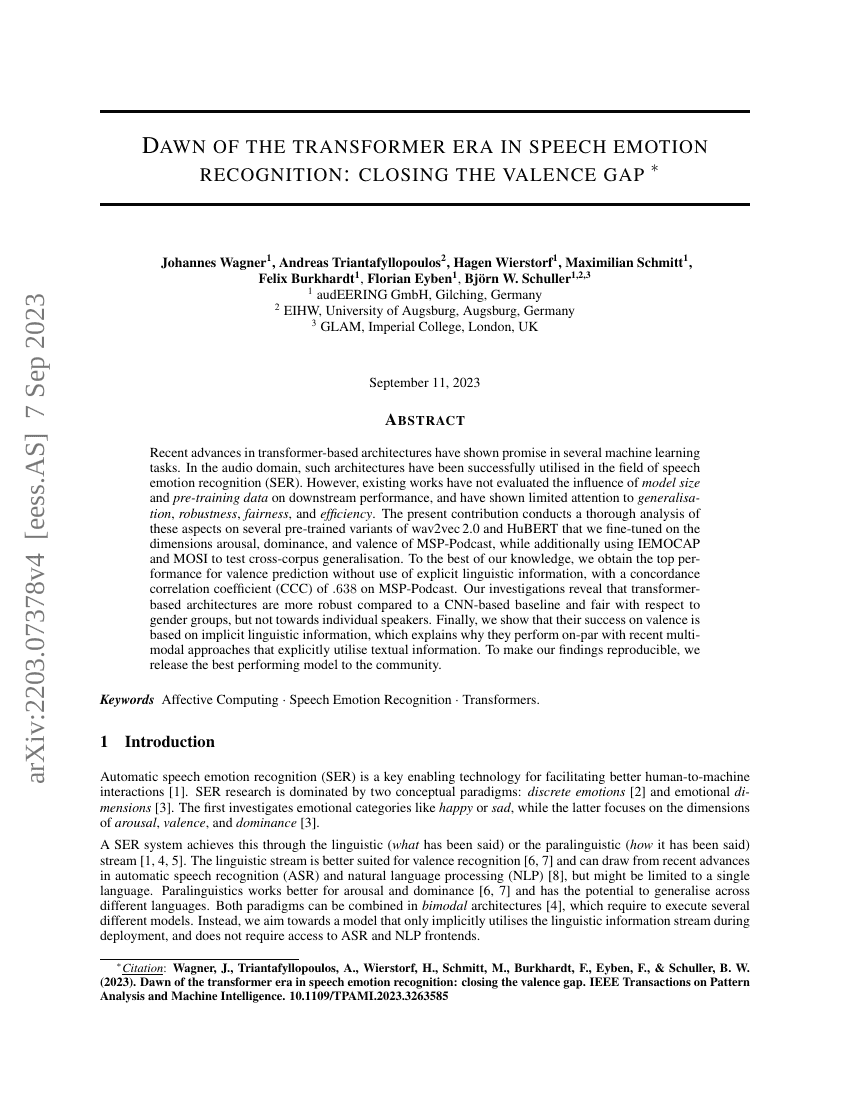Command Palette
Search for a command to run...
Dawn of the transformer era in speech emotion recognition: closing the valence gap
Johannes Wagner Andreas Triantafyllopoulos Hagen Wierstorf Maximilian Schmitt Felix Burkhardt Florian Eyben Björn W. Schuller

Abstract
Recent advances in transformer-based architectures which are pre-trained in self-supervised manner have shown great promise in several machine learning tasks. In the audio domain, such architectures have also been successfully utilised in the field of speech emotion recognition (SER). However, existing works have not evaluated the influence of model size and pre-training data on downstream performance, and have shown limited attention to generalisation, robustness, fairness, and efficiency. The present contribution conducts a thorough analysis of these aspects on several pre-trained variants of wav2vec 2.0 and HuBERT that we fine-tuned on the dimensions arousal, dominance, and valence of MSP-Podcast, while additionally using IEMOCAP and MOSI to test cross-corpus generalisation. To the best of our knowledge, we obtain the top performance for valence prediction without use of explicit linguistic information, with a concordance correlation coefficient (CCC) of .638 on MSP-Podcast. Furthermore, our investigations reveal that transformer-based architectures are more robust to small perturbations compared to a CNN-based baseline and fair with respect to biological sex groups, but not towards individual speakers. Finally, we are the first to show that their extraordinary success on valence is based on implicit linguistic information learnt during fine-tuning of the transformer layers, which explains why they perform on-par with recent multimodal approaches that explicitly utilise textual information. Our findings collectively paint the following picture: transformer-based architectures constitute the new state-of-the-art in SER, but further advances are needed to mitigate remaining robustness and individual speaker issues. To make our findings reproducible, we release the best performing model to the community.
Code Repositories
Benchmarks
| Benchmark | Methodology | Metrics |
|---|---|---|
| emotion-recognition-on-msp-podcast | w2v2-L-robust-12 | Concordance correlation coefficient (CCC): 0.638 |
| speech-emotion-recognition-on-msp-podcast | w2v2-L-robust-12 | CCC: 0.638 |
| speech-emotion-recognition-on-msp-podcast-1 | w2v2-L-robust-12 | CCC: 0.745 |
| speech-emotion-recognition-on-msp-podcast-2 | w2v2-L-robust-12 | CCC: 0.655 |
Build AI with AI
From idea to launch — accelerate your AI development with free AI co-coding, out-of-the-box environment and best price of GPUs.